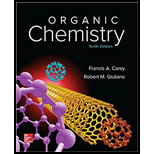
ORGANIC CHEMISTRY (LOOSELEAF)-PACKAGE
10th Edition
ISBN: 9781260008562
Author: Carey
Publisher: MCG
expand_more
expand_more
format_list_bulleted
Concept explainers
Question
Chapter 16, Problem 41DSP
Interpretation Introduction
Interpretation:
The phrase that best describes the stereo-chemistry of the product formed in the pinacol re-arrangement of the
Concept Introduction:
A carbon atom when attached to four different atoms or groups is called a chiral carbon.
An achiral carbon either has no chiral carbons or has a symmetry element in it.
Enantiomers are the mirror images which are non-superimposable.
Racemic mixtures contain equal proportion of two enantiomers of a compound. The mixture is optically inactive.
Expert Solution & Answer
Want to see the full answer?
Check out a sample textbook solution
Students have asked these similar questions
3) Determine if the pairs are constitutional isomers, enantiomers, diastereomers, or mesocompounds.
(4 points)
In the decomposition reaction in solution B → C, only species C absorbs UV radiation, but neither B nor the solvent absorbs. If we call At the absorbance measured at any time, A0 the absorbance at the beginning of the reaction, and A∞ the absorbance at the end of the reaction, which of the expressions is valid? We assume that Beer's law is fulfilled.
>
You are trying to decide if there is a single reagent you can add that will make the following synthesis possible without any other
major side products:
1. ☑
CI
2. H3O+
O
Draw the missing reagent X you think will make this synthesis work in the drawing area below.
If there is no reagent that will make your desired product in good yield or without complications, just check the box under the
drawing area and leave it blank.
Click and drag to start drawing a
structure.
Explanation
Check
?
DO
18
Ar
B
© 2025 McGraw Hill LLC. All Rights Reserved. Terms of Use | Privacy Center | Accessibility
Chapter 16 Solutions
ORGANIC CHEMISTRY (LOOSELEAF)-PACKAGE
Ch. 16.2 - Prob. 1PCh. 16.2 - Prob. 2PCh. 16.4 - Prob. 3PCh. 16.5 - Prob. 4PCh. 16.5 - Give the structures, including stereochemistry,...Ch. 16.5 - Prob. 6PCh. 16.7 - Prob. 7PCh. 16.8 - Prob. 8PCh. 16.8 - Prob. 9PCh. 16.9 - Predict the principal organic product of each of...
Ch. 16.9 - Prob. 11PCh. 16.10 - Prob. 12PCh. 16.11 - Prob. 13PCh. 16.12 - Prob. 14PCh. 16.12 - Prob. 15PCh. 16 - Write chemical equations, showing all necessary...Ch. 16 - Write chemical equations, showing all necessary...Ch. 16 - Which of the isomeric C5H12O alcohols can be...Ch. 16 - Prob. 19PCh. 16 - Write equations showing how 1-phenylethanol could...Ch. 16 - Write equations showing how 2-phenylethanol could...Ch. 16 - Prob. 22PCh. 16 - Show how each of the following compounds can be...Ch. 16 - Prob. 24PCh. 16 - Write the structure of the principal organic...Ch. 16 - Prob. 26PCh. 16 - Prob. 27PCh. 16 - Prob. 28PCh. 16 - Prob. 29PCh. 16 - Prob. 30PCh. 16 - (a) The cis isomer of 3-hexen-1-ol...Ch. 16 - Prob. 32PCh. 16 - Complete each of the following equations by...Ch. 16 - Prob. 34PCh. 16 - Prob. 35PCh. 16 - A diol (C8H18O2) does not react with periodic...Ch. 16 - Identify the compound C8H10O on the basis of its...Ch. 16 - dentify each of the following C4H10O isomers on...Ch. 16 - Prob. 39PCh. 16 - A compound C6H14O has the spectrum shown in Figure...Ch. 16 - Prob. 41DSPCh. 16 - Prob. 42DSPCh. 16 - Prob. 43DSPCh. 16 - Prob. 44DSPCh. 16 - Prob. 45DSPCh. 16 - Prob. 46DSPCh. 16 - Prob. 47DSP
Knowledge Booster
Learn more about
Need a deep-dive on the concept behind this application? Look no further. Learn more about this topic, chemistry and related others by exploring similar questions and additional content below.Similar questions
- Don't use ai to answer I will report you answerarrow_forwardConsider a solution of 0.00304 moles of 4-nitrobenzoic acid (pKa = 3.442) dissolved in 25 mL water and titrated with 0.0991 M NaOH. Calculate the pH at the equivalence pointarrow_forwardWhat is the name of the following compound? SiMe3arrow_forward
- K Draw the starting structure that would lead to the major product shown under the provided conditions. Drawing 1. NaNH2 2. PhCH2Br 4 57°F Sunny Q Searcharrow_forward7 Draw the starting alkyl bromide that would produce this alkyne under these conditions. F Drawing 1. NaNH2, A 2. H3O+ £ 4 Temps to rise Tomorrow Q Search H2arrow_forward7 Comment on the general features of the predicted (extremely simplified) ¹H- NMR spectrum of lycopene that is provided below. 00 6 57 PPM 3 2 1 0arrow_forward
arrow_back_ios
SEE MORE QUESTIONS
arrow_forward_ios
Recommended textbooks for you
 Organic ChemistryChemistryISBN:9781305580350Author:William H. Brown, Brent L. Iverson, Eric Anslyn, Christopher S. FootePublisher:Cengage Learning
Organic ChemistryChemistryISBN:9781305580350Author:William H. Brown, Brent L. Iverson, Eric Anslyn, Christopher S. FootePublisher:Cengage Learning
 Organic And Biological ChemistryChemistryISBN:9781305081079Author:STOKER, H. Stephen (howard Stephen)Publisher:Cengage Learning,
Organic And Biological ChemistryChemistryISBN:9781305081079Author:STOKER, H. Stephen (howard Stephen)Publisher:Cengage Learning, General, Organic, and Biological ChemistryChemistryISBN:9781285853918Author:H. Stephen StokerPublisher:Cengage Learning
General, Organic, and Biological ChemistryChemistryISBN:9781285853918Author:H. Stephen StokerPublisher:Cengage Learning Macroscale and Microscale Organic ExperimentsChemistryISBN:9781305577190Author:Kenneth L. Williamson, Katherine M. MastersPublisher:Brooks Cole
Macroscale and Microscale Organic ExperimentsChemistryISBN:9781305577190Author:Kenneth L. Williamson, Katherine M. MastersPublisher:Brooks Cole

Organic Chemistry
Chemistry
ISBN:9781305580350
Author:William H. Brown, Brent L. Iverson, Eric Anslyn, Christopher S. Foote
Publisher:Cengage Learning


Organic And Biological Chemistry
Chemistry
ISBN:9781305081079
Author:STOKER, H. Stephen (howard Stephen)
Publisher:Cengage Learning,

General, Organic, and Biological Chemistry
Chemistry
ISBN:9781285853918
Author:H. Stephen Stoker
Publisher:Cengage Learning

Macroscale and Microscale Organic Experiments
Chemistry
ISBN:9781305577190
Author:Kenneth L. Williamson, Katherine M. Masters
Publisher:Brooks Cole
Alcohols, Ethers, and Epoxides: Crash Course Organic Chemistry #24; Author: Crash Course;https://www.youtube.com/watch?v=j04zMFwDeDU;License: Standard YouTube License, CC-BY